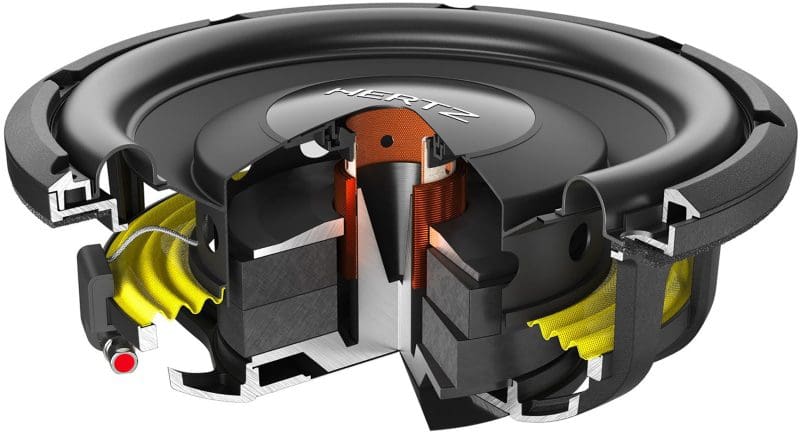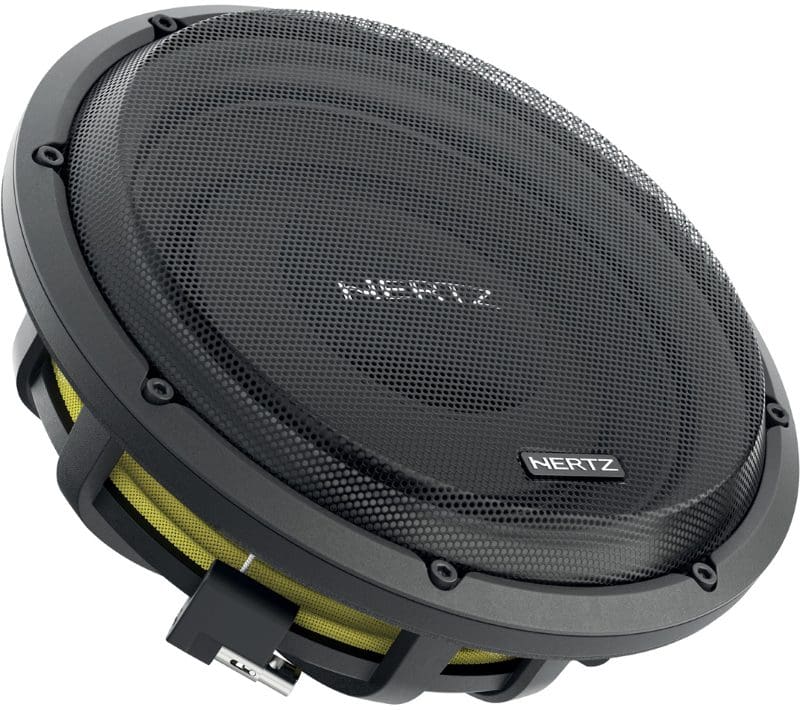Pickup truck sales per year have more than tripled in the last three decades. With millions of these vehicles on the road, it’s no wonder that the popularity of shallow-mount subwoofers has increased dramatically. Hertz has recently introduced 10- and 12-inch shallow subwoofers in their top-of-the-line Mille series. These subwoofers are rated to handle 500 watts of power continuously, function in ultra-compact enclosures and provide impressive output capabilities. We have the 10-inch, single 2-ohm voice coil MPS 250 S2 in the BestCarAudio.com lab for this Test Drive Review.
Features of the Hertz MPS 250 S2
The MPS 250 S2 is based on a proprietary cast aluminum frame with eight spokes. A set of horizontally mounted chrome spring terminals will accept speaker wires up to 8 AWG. The terminals have been oriented so that the wire exits toward the back of the enclosure and won’t interfere with the installation. Speaking of installation, there is no cooling vent in the bottom plate. We’ll discuss how Hertz manages power handling shortly. In the meantime, this lack of the vent means that the subwoofer can be installed right up against the back of the enclosure to minimize mounting depth requirements. The MPS 250 S2 and its brother, the MPS 250 S4, need only 3.25 inches from the face of the enclosure to the back panel.
The cone assembly is injection molded from polypropylene and includes a large outer ring that extends downward around the motor assembly to attach to the unconventionally large-diameter spider. Large vent holes in this ring allow hot air to escape from the voice coil. A large rubber surround provides a reliable, flexible connection between the outer edge of the cone and the basket.

A 1.5-inch former is attached to the center of the cone with a secondary reinforcing ring that increases surface area and rigidity. The voice coil itself is a monstrous six-layer design that’s rated for 500 watts of continuous power handling and has a peak rating of 1,000 watts. There are also a number of cooling vents in the voice coil former between where the winding ends, and it is bonded to the cone. When the cone moves rearward, hot air is forced out of these holes and the holes in the vertical spider support. When the driver moves forward, cooler air is sucked in through the same path to help extract heat. Hertz calls this their Air Intercooling Revolution (AIR) design. A secondary benefit of this design is a drastic reduction in air pressurization as the cone moves forward and rearward, which improves linearity.
The Hertz AIR cooling system allows for heat extraction and pressure reduction under the cone assembly.
The motor assembly is based on a pair of stacked ceramic magnets. The T-yoke features an extended center pole piece that rises well above the magnetic gap. This extended pole design improves the linearity of the magnetic field on the voice coil. The result is that the motor force is more linear in both directions, which results in reduced distortion and increased output capabilities.

Hertz Shallow Subwoofer Specifications
Taking a look at the owner’s manual for the MPS subwoofers, Hertz recommends a 0.5-cubic-foot acoustic suspension (sealed) enclosure or an impressively small bass reflex (vented) design of 0.6 cubic foot and a tuning frequency of 35 hertz. In most cases, enclosures with dimensions this small are provided based on what competing products claim their drivers are capable of. However, I started this review by measuring the Thiele/Small parameters of the MPS 250 S2 before and after an eight-hour break-in cycle. I then proceeded to compare the factory-provided specifications and my measurements in the provided enclosure design. Though my numbers vary a bit, with slightly higher Fs and a more compliant Vas, both enclosure designs are impressive in terms of their predicted performance.
The 0.5-cubic-foot acoustic suspension enclosure is predicted to have a Qtc of exactly 0.7 and an F3 of 60 hertz based on my measurements. That’s a perfect balance of output and low-frequency extension. Even when driven with 500 watts of power, the simulation software predicts driver excursion won’t exceed 10 mm in this design at the lowest of frequencies.

I was curious about the predicted response of the small vented enclosure but was pleased to find that the design simply improves efficiency across the board. There’s 4.3 dB more output at 35 hertz from the bass reflex enclosure at the same power level as the acoustic suspension design. The bass-reflex enclosure is louder than two drivers in a 1.0-cubic-foot acoustic suspension enclosure with the same 500 watts. If you want the most bang for your buck, you know what to ask for from your installer.

One thing you’ll notice in both of these graphs is that there is a significant amount of high-frequency attenuation in both simulations. While a six-layer voice coil performs well in terms of power handling, the drawback is that it creates a great deal of inductance that acts like a passive low-pass filter. I measured an inductance of 3.35 millihenries. You’ll want to use these subwoofers with a midbass driver that’s robust. If you can fit a 6×9 in the doors of your truck, that would be great! The built-in electro-mechanical attenuation may also affect the phase around the crossover point. To get these subs to blend with the midbass speakers well, you might need to use a shallower than normal crossover slope, assuming you are using a digital signal processor. With that said, the high inductance due to the multi-layer coil was a conscious and logical design decision. Given the desire for significant power-handling requirements, it makes sense.

If you’ve read a number of my reviews, you know I pay close attention to how the subwoofer behaves when I’m breaking it in. I was thoroughly impressed by the excursion capabilities of the MPS 250 S2 outside of an enclosure. The cone was moving forward and rearward over an inch and a half, giving credence to its 16.8-mm/0.66-inch Xmax specification. There was a good amount of audible air turbulence under the cone, letting me know the AIR cooling system was working. I never heard the driver get really upset, even when I attempted to overpower it. I expect this subwoofer will move a LOT of air in the listening room.
The driver parameters do shift noticeably after the break-in. You may want to have your audio system recalibrated after 100-or-so hours of playtime.
Before I dive into the listening evaluation, we should discuss the driver’s dimensions. The MPS 250 S2 requires 3.25 inches of mounting depth. As I mentioned, there’s no vent on the back, so the sub can be right up against the rear of the enclosure. The grille included with the MPS 250 S2 sub is 1.53 inches tall, so you’ll need about 1.75 inches in front of the sub for everything to fit and function properly.


Auditioning the Hertz MPS 250 S2 Car Audio Subwoofer
Given what will likely be the most common application for this subwoofer, I decided to test it in a 0.5-cubic-foot sealed enclosure. I added the subwoofer to my reference system and connected it to my 2,500-watt subwoofer amplifier. I made sure the output level around the 80-hertz crossover point matched my target response curve in the room before I began the listening tests.
The first track I listened to was Depeche Mode’s “Enjoy the Silence.” In particular, this was a remix called the Ricki Tik Tik Mix. This track has a great bass line that gives both the subwoofer and what would be the door speakers an impressive workout. The MPS 250 S2 had a good balance of punch, but in the listening room, it needed a little more rumble. I dialed in about 6 dB of boost at 30 hertz on the subwoofer amplifier, then repeated the track. Now the bass was full and deep. You won’t need this boost in the car, as the transfer function of the small space gives you this gain (and more) automatically.
The next song was another retro remix. This time, it was the New York Mix of Frankie Goes to Hollywood’s “Relax.” Yeah, I’m in a retro mood this week. This song has an even punchier bass line. That showed off some of the inductance in the voice coil, as the beat wasn’t razor-sharp. With that said, it produced significantly more output than most shallow subwoofers I’ve heard!
Up next was “Chocolate Chip Trip” by Tool. This track is pretty funky and has a great kick drum recording. The balance of the MPS 250 S2 was great on this song. There was musicality in the kick drum sound, not just a “bump” or “boomf” as happens with poorly designed speakers. The integration with my bookshelf speakers was impressive. All the bass seemed to come from them rather than being localized to the subwoofer. This indicates low harmonic distortion characteristics. That’s something not many subwoofers of any dimension can claim to offer.
I finished the listening session with “On the Floor” by Jennifer Lopez. This song got turned up quite loud, much to the chagrin of the rest of the people near the listening room. If anyone asks, I’m working, OK?! The output was absolutely impressive for a shallow-mount 10-inch driver in a small sealed enclosure. I’ve heard many 12-inch conventional-depth subwoofers that would have been flopping all over the place at these volume levels. The power light on the amp was dimming with each beat – meaning I was at an output level I rarely ever approach. The Hertz MPS 250 S2 didn’t seem to mind at all, even with the deepest bass in the track. It remained composed and impressively musical.
Overall, the MPS 250 S2 subwoofer is a driver worthy of being included in the Mille family of products from Hertz. It sounds very good and actually plays low in a small enclosure without getting sloppy or being boomy. What a magnificent experience!
Big Bass That Doesn’t Need Much Space
I’ve heard a lot of shallow and small enclosure subwoofers in the last few years. Very few of them were impressive on a level that matches the MPS 250 S2. This driver loves the small enclosure volume, handles crazy amounts of power, gets loud and sounds very good. If you want musical bass that will get astonishingly loud in your truck, drop by a local authorized Hertz retailer and ask for a demonstration of the new Mille shallow-mount subwoofers. You can learn more about Hertz products by visiting their website and their Facebook and Instagram pages. They also have an informative YouTube channel that explains the features of many of their products.


